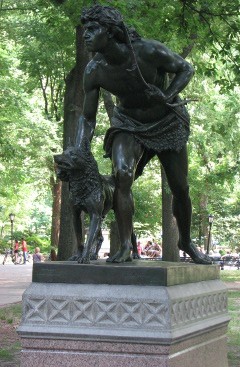"Indian Hunter"

Even though one of America’s finest sculptors created it, the “Indian Hunter” statue occupies an obscure spot in Central Park just outside the Sheep Meadow, on a modestly traveled path toward The Mall and its array of white authors and Christopher Columbus.
But maybe that is exactly right. Like the mythical native shown hunting in the forest he called home, the statue by John Quincy Adams Ward is barely visible in shadows cast by tall trees.
Some, apparently, were beginning even in the mid-19th Century to question whether white Europeans’ “stern impassioned stress” did actually “a thoroughfare for freedom beat across the wilderness.”
In her poem that inspired the statue, Eliza Cook wrote, “Oh! why does the white man follow my path, Like the hound on the tiger’s track?” She concluded, “Then back, go back from the red man’s track, For the hunter’s eyes grow dim, To find that the white man wrongs the one Who never did harm to him.”
It’s an ethical quandary that still haunts a city where the fabulous got fabulous by abusing workers and breaking strikes (Carnegie, Rockefeller and Frick), claiming land owned by others (Vanderbilt, Harriman), and dipping an insatiable bucket into wealth created by others (Morgan, Chase).
American freedom came at a price: not only the price paid by those who overthrew an empire and defended the nation against fascism and terrorism, but the price paid by the land’s original owners and by immigrants who toiled hard but saw little reward.
Beneath the flag that marks our homeland, we should honor all of those sacrifices.
